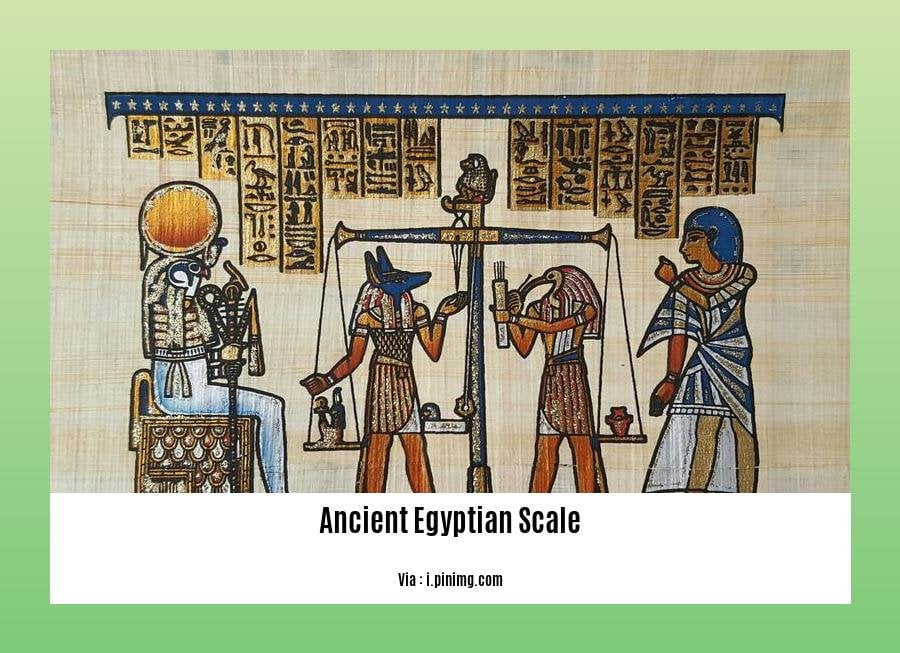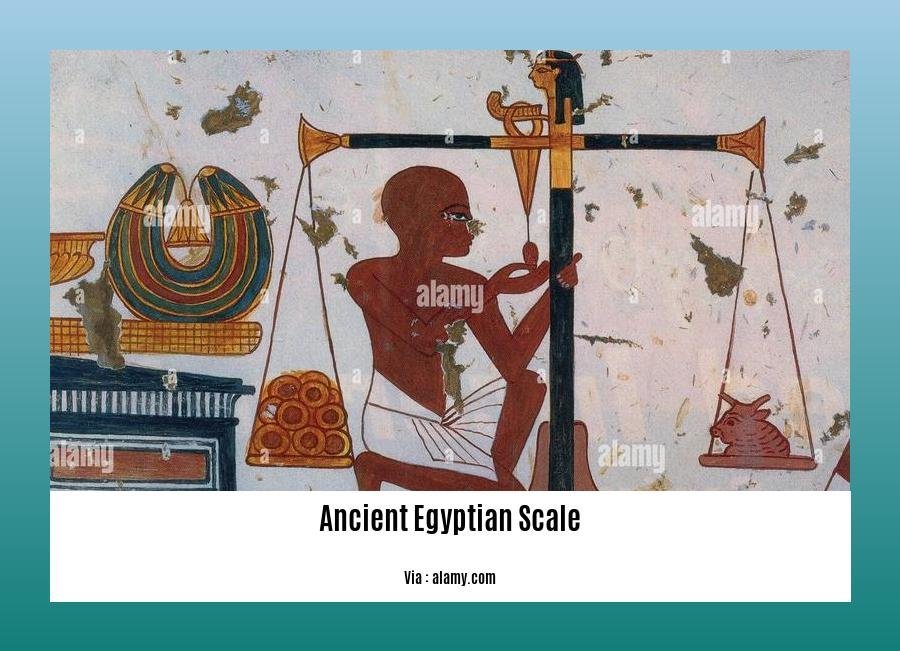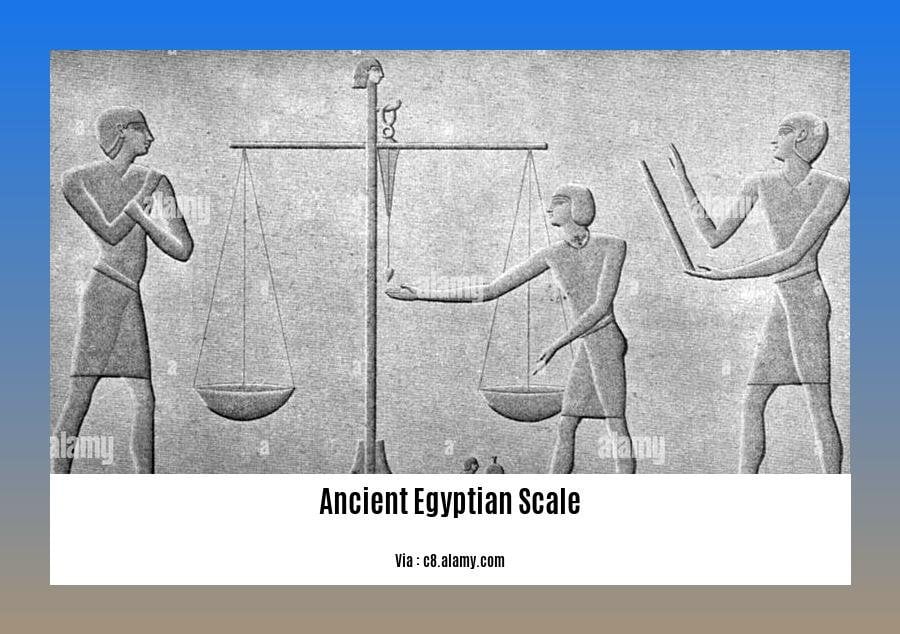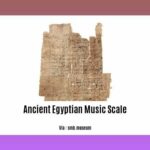Journey back in time to the remarkable civilization of ancient Egypt, where the intricate scales of measurement played a pivotal role in shaping their sophisticated society. Discover the [Ancient Egyptian Scale: Unveiling the Secrets of Measurement in Pharaonic Civilization], a testament to the ingenuity and precision of the ancient Egyptians.
Key Takeaways:
- The ancient Egyptian scale was a pentatonic scale consisting of five notes.
- The intervals between the notes were: Root/Prime (1P), Major 2nd (2M), Perfect 4th (4P), Perfect 5th (5P), and Minor 7th (7m).
- The scale is also known as the 2nd mode of the major pentatonic scale.
- There is no evidence that the ancient Egyptians understood the concepts of tonic, major, and minor, but they may have used a seven-tone scale during the Empire period.
- The origin of the diatonic scale, the precursor to modern musical scales is associated with Pythagoras, a Greek philosopher and mathematician who lived around 500 BC.
Ancient Egyptian Scale


Delving into the depths of ancient Egyptian history, we uncover a civilization that not only possessed remarkable architectural prowess and hieroglyphic literacy but also displayed an advanced understanding of measurement and weighing systems. Their intricate ancient Egyptian scale served as a cornerstone of their sophisticated society, facilitating trade, construction, and various other aspects of daily life.
Historical Significance
The ancient Egyptian scale emerged during the Old Kingdom period (c. 2686-2181 BC) and underwent refinement over the centuries. It consisted of a standardized set of units of measurement, meticulously defined and employed across the realm. This scale played a pivotal role in ensuring accuracy and consistency in various domains, including trade, taxation, and construction projects of colossal proportions.
Units of Measurement
The foundation of the ancient Egyptian scale rested upon three fundamental units: the cubit, the palm, and the finger. The cubit, the primary unit of length, derived its name from the length of the forearm from the elbow to the tip of the middle finger. Subdivided into smaller increments, the cubit facilitated precise measurements in diverse applications.
- Cubit: Approximately 52.3 centimeters or 20.6 inches, the standard cubit provided a common reference point for linear measurements.
- Palm: Equivalent to four fingers in width, the palm served as a convenient unit for measuring smaller lengths and distances.
- Finger: The smallest unit in the ancient Egyptian scale, the finger represented the width of a single finger.
Application in Trade and Construction
The ancient Egyptian scale proved indispensable in facilitating trade and commerce. Merchants utilized the standardized units to ensure公平交易, preventing disputes and maintaining trust among trading partners. The scale also played a crucial role in monumental construction projects, ensuring the precise alignment and symmetry of structures such as pyramids and temples.
Legacy and Influence
The ancient Egyptian scale stands as a testament to the ingenuity and intellectual achievements of this ancient civilization. Its enduring legacy can be traced through various civilizations that adopted and adapted its principles. The scale’s influence is evident in the Roman and Babylonian systems of measurement and continues to resonate in modern metrology.
Conclusion
The ancient Egyptian scale stands as a remarkable feat of engineering and organization, embodying the mathematical prowess of this ancient civilization. Its widespread use in trade, construction, and various other domains underscores its significance in shaping the infrastructure and societal fabric of ancient Egypt. As we delve deeper into the complexities of this scale, we gain a profound appreciation for the sophistication and enduring contributions of the ancient Egyptians to the realm of measurement and metrology.
Seeking knowledge on ancient gold dragons in Dungeons & Dragons? Explore our comprehensive guide to learn more about their abilities, attacks, and strategies for defeating this legendary creature in your campaign. Ancient Gold Dragon 5e
Discover the truth behind the legitimacy of Ancient Artifacts Shop. Read our thorough review to see if the shop delivers on its promises of authentic and valuable artifacts. Ancient Artifacts Shop Legit
Explore the captivating history and alluring qualities of Ancient Arts Yarn. Unravel the secrets of its unique fibers, craftsmanship, and its rich symbolism in various cultures. Ancient Arts Yarn
Egyptian Scales Of Judgement
In ancient Egypt, the Scales of Judgement played a pivotal role in determining the fate of individuals in the afterlife. This intricate ritual, governed by the principles of Ma’at (truth and balance), involved a meticulous process of weighing the heart against the feather of Ma’at to determine the deceased’s righteousness.
Key Takeaways:
The ancient Egyptians believed in a well-defined afterlife, where the heart was seen as the center of morality.
During the Weighing of the Heart ceremony, the deceased’s heart was placed on one side of the scale, while the feather of Ma’at—representing truth and balance—was placed on the other.
Osiris, the god of the underworld, presided over this crucial ritual, ensuring fairness and justice.
If the heart balanced or outweighed the feather, the deceased was deemed worthy of entering the idyllic Field of Reeds, a paradise in the afterlife.
Conversely, those whose hearts were heavier than the feather were deemed unworthy and faced dire consequences, including being devoured by Ammit, a monstrous creature, and denied entry into the afterlife.
The Weighing of the Heart ritual showcased the profound significance of living a righteous life according to the principles of Ma’at. It served as a moral compass for the ancient Egyptians, guiding their actions and beliefs throughout their earthly existence.
Sources:
The Afterlife and Judgment in Ancient Egypt
FAQ
Q1: What was the significance of the Ancient Egyptian scales of justice?
A1: The Ancient Egyptian scales of justice, known as the Scales of Judgement, were central to the belief in the afterlife. They served as a symbol of Ma’at (truth and balance) and determined the fate of the deceased based on their moral conduct.
Q2: How did the weighing process work in the Scales of Judgement?
A2: During the weighing process, the heart of the deceased was placed on one side of the scale, while the feather of Ma’at (the feather of truth) was placed on the other. If the heart balanced or outweighed the feather, the deceased was deemed righteous and granted access to the afterlife.
Q3: Who presided over the Scales of Judgement?
A3: Osiris, the god of the underworld and the afterlife, presided over the Scales of Judgement. He ensured fairness and justice during the weighing process, determining the fate of the deceased based on their actions and deeds in life.
Q4: What happened to the heart if it was heavier than the feather of Ma’at?
A4: If the heart of the deceased was heavier than the feather of Ma’at, it was devoured by Ammit, a monstrous creature with the head of a crocodile, the body of a lion, and the hindquarters of a hippopotamus. This resulted in the denial of entry into the afterlife.
Q5: What was the purpose of the Ancient Egyptian weighing scales?
A5: The Ancient Egyptian weighing scales were primarily used for weighing precious metals, grains, and other commodities. They played a crucial role in facilitating trade and ensuring fairness in transactions. Additionally, they were employed in religious ceremonies and rituals, including the weighing of the heart in the Scales of Judgement.
- Senior at What Age: Benefits & Eligibility Guide - March 29, 2025
- Unlocking Senior Benefits: How Old is a Senior? Your Complete Guide - March 29, 2025
- Master Russian Politeness:A Guide to Saying Please - March 29, 2025
















